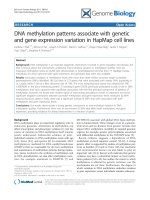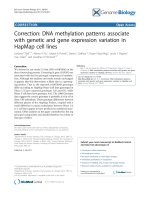Combining ability and gene action studies in pearl millet using line X tester analysis under arid conditions
Bạn đang xem bản rút gọn của tài liệu. Xem và tải ngay bản đầy đủ của tài liệu tại đây (188.91 KB, 9 trang )
Int.J.Curr.Microbiol.App.Sci (2019) 8(4): 976-984
International Journal of Current Microbiology and Applied Sciences
ISSN: 2319-7706 Volume 8 Number 04 (2019)
Journal homepage:
Original Research Article
/>
Combining Ability and Gene Action Studies in Pearl Millet using
Line x Tester Analysis under Arid Conditions
Kana Ram Kumawat1*, P.C. Gupta2 and N.K. Sharma3
1
Department of Genetics and Plant Breeding, College of Agriculture, 2Agricultural Research
Station and 3Institute of Agri Business Management, Swami Keshwanand Rajasthan
Agricultural University, Bikaner, Rajasthan-334006, India
*Corresponding author
ABSTRACT
Keywords
Combining ability,
gene action, Pearl
millet, Line × tester
analysis, Crosses,
Yield
Article Info
Accepted:
10 March 2019
Available Online:
10 April 2019
Present investigation was carried out to study combining ability along with inheritance of
grain yield and its component traits in 50 hybrids of pearl millet which were generated
through line x tester mating design using 5 male sterile lines and 10 restorers as parental
material at ICRISAT, Hyderabad during Summer, 2018. These hybrids were evaluated in
randomized block design with 3 replications in 3 environments during Kharif, 2018 at
Agricultural Research Station, Bikaner. In results, both GCA and SCA variances were
found significant for majority of characters. The ratio of GCA and SCA variance indicated
the predominance of non-additive gene action for all the characters studied. GCA effects
revealed that parents like ICMA 843-22, RMS 7A (female), BIB-423, BIB-343, BIB-451
and BIB-407 (male) were good general combiners for grain yield and some contributing
characters. On the basis of SCA effects the crosses namely RMS 7A x BIB-407, ICMA
843-22 x BIB-343, ICMA 843-22 x BIB-451, ICMA 88004 x BIB-423 and ICMA 93333 x
BIB-439 were identified as superior for seed yield and related traits over the environments.
Therefore these parents and hybrids are recommended for utilization in development of
promising hybrids as well as their use in population improvement.
management conditions. As a food grain, its
grain possesses the highest amount of calories
per 100 gram (Burton et al., 1972), which is
mainly supplied by carbohydrates, fats and
proteins (Flech, 1981). It is extensively
cultivated as dual purpose crop over large
areas in many countries including India. Pearl
millet being a C4 plant species has high
photosynthetic efficiency and dry matter
production. Its plants are highly heterozygous
because of its cross-pollinating nature due to
Introduction
Pearl millet [Pennisetum glaucum (L.) R.
Br.], which is also known as cat tail, spiked
tail, bulrush millet and bajra is quick growing
short duration crop having high tillering,
drought and heat tolerance and well adapted
to different type of soils. It is traditionally
grown as rainfed crop mostly under low
fertility and rainfall conditions. However, it
also responds well to irrigation and improved
976
Int.J.Curr.Microbiol.App.Sci (2019) 8(4): 976-984
protogyny. When the most widely used
cytoplasmic male sterile line, Tift 23A, was
released (Burton, 1965) it speed up the
improvement work in pearl millet. The choice
of right type of parent is a crucial step for a
plant breeder which requires extensive and
detailed genetical studies of existing
germplasm as well as newly evolved
promising lines. The combining ability
provides guideline to a plant breeder in
selecting the elite parents and desirable
crosses to be used in formulation of
systematic breeding programme and provides
means of understanding the nature of gene
action involved in the inheritance of various
characters. With this perspective, the present
investigation was carried out to estimate the
combining ability variances and effects in
crosses along with study of various
components of genetic variation and to
suggest suitable breeding strategy for
improvement of yield under various
environments with special respect to arid
conditions.
number of irrigations (The environment E1, E2
and E3 were provided three, two and one
irrigations, respectively) at Agricultural
Research Station, Bikaner during Kharif,
2018. Each plot consisted of two rows each of
4 meter length with row spacing of 60 cm and
plant to plant spacing of 15 cm. All
recommended cultural practices were
followed to raise good crop. The observations
were recorded on twelve morphological
characters namely days to 50% flowering,
days to maturity, plant height (cm), total
number of tillers per plant, number of
effective tillers per plant, flag leaf area (cm2),
ear head length (cm), ear head diameter (cm),
test weight (g), dry stover yield per plant (g),
grain yield per plant (g) and harvest index
(%). The mean data were subjected to analyze
combining ability as per the method
suggested by Kempthorne (1957).
Materials and Methods
The pooled analysis of variance for
combining ability (Table 1) showed
significant mean sum of squares due to
environments, crosses, line x tester and
crosses x environment for all the characters
which indicated presence of significant
variations among the material used for study.
Mean sum of squares due to lines were found
significant for days to maturity, ear head
length, ear head diameter, dry stover yield per
plant and grain yield per plant while the tester
mean sum of squares were found significant
for days to 50% flowering, days to maturity
and plant height. Perusal of Table 2 indicated
that the magnitude of variance due to GCA
was lower as compared to magnitude of SCA
for all the characters over the environments
which indicated the preponderance of nonadditive components for all the characters
over the environments while significant
magnitude of variance due to both GCA and
Results and Discussion
Combining ability analysis
The experimental material for present study
consisted of 5 male sterile lines (RMS 7A
from Rajasthan Agricultural Research
Institute, Jaipur, Rajasthan and ICMA 843-22,
ICMA 88004, ICMA 93333 and ICMA 97111
from The International Crops Research
Institute for the Semi-Arid Tropics,
Hyderabad) and 10 testers (BIB-343, BIB359, BIB-383, BIB-391, BIB-399, BIB-407,
BIB-415, BIB-423, BIB-439 and BIB-451
which were collected from AICRP on Pearl
Millet, Bikaner, Rajasthan). The 50 crosses
were generated using line x tester mating
design at International Crop Research
Institute for the Semi-Arid Tropics
(ICRISAT), Hyderabad during Summer, 2018.
These hybrids were grown in randomized
block design with three replications in three
environments created by differentiating
977
Int.J.Curr.Microbiol.App.Sci (2019) 8(4): 976-984
SCA indicated the importance of both
additive and non-additive components in the
inheritance of majority of the characters
studied. The proportional contribution of
lines, testers and their interaction to total
variance (%) over the environments (Table 2)
showed maximum contribution of lines to
total variance for dry stover yield per plant
(50.09%) followed by ear head diameter
(32.15%). The maximum contribution of
tester to total variance was for plant height
(36.79%) followed by days to 50% flowering
(33.72%) and the line x tester interaction
displayed maximum contribution to total
variance for number of effective tillers per
plant (81.08%) followed by total number of
tillers per plant (76.55%) over the
environments. Similar results were also
reported in pearl millet by Jeeterwal et al.,
(2017), Kumar et al., (2017), Solanki et al.,
(2017) and Badurkar et al., (2018) regarding
combining ability and gene actions.
plant. ICMA 93333 was good general
combiner for days to maturity, total number
of tillers per plant, ear head diameter, dry
stover yield per plant and grain yield per plant
and ICMA 88004 for plant height, test weight
and harvest index. The tester or male parent
BIB-343 was good general combiner for
characters namely days to 50% flowering,
days to maturity total number of tillers per
plant, number of effective tillers per plant, ear
head length, grain yield per plant and harvest
index while BIB-423 for days to 50%
flowering, total number of tillers per plant,
number of effective tillers per plant, test
weight, dry stover yield per plant, grain yield
per plant and harvest index, BIB-451 for days
to maturity and grain yield per plant, BIB-383
for days to 50% flowering, days to maturity,
total number of tillers per plant, number of
effective tillers per plant and ear head length,
BIB-359 for plant height, BIB-407 for plant
height, flag leaf area, ear head diameter and
dry stover yield per plant and BIB-415 for ear
head length and test weight. Krishnan et al.,
(2017), Ladumor et al., (2018), Saini et al.,
(2018) and Santosh et al., (2018) also
reported various lines and testers having good
combining ability behavior for yield and its
attributing characters in pearl millet. Top
three crosses on the basis of high SCA effects
for different characters are presented in Table
3. The cross combinations with significant
and high (highest three) SCA effects for at
least three or more characters were RMS 7A x
BIB-407 for characters namely grain yield per
plant, ear head length, ear head diameter and
harvest index, ICMA 843-22 x BIB-343 for
grain yield per plant, number of effective
tillers per plant and total number of tillers per
plant, ICMA 88004 x BIB-423 for dry stover
yield per plant, number of effective tillers per
plant and total number of tillers per plant and
ICMA 97111 x BIB 391 for number of
effective tillers per plant, total number of
tillers per plant and days to 50% flowering.
GCA and SCA effects
The GCA and SCA effects in this section are
based on the data pooled over the three
environments. The best performing parents
(lines and testers) and cross combinations on
the basis of GCA and SCA effects (Table 3)
revealed that none of the parents was found
good general combiner for all the characters
which suggested breeding for these characters
would be effective when material is tested
over a wide range of environments. The
female line ICMA 843-22 proved to be good
general combiner as it showed significant
GCA effects for nine characters namely days
to 50% flowering, days to maturity, plant
height, total number of tillers per plant, ear
head diameter, test weight, dry stover yield
per plant, grain yield per plant and harvest
index while RMS 7A was good general
combiner for days to maturity, total number
of tillers per plant, ear head diameter, dry
stover yield per plant and grain yield per
978
Int.J.Curr.Microbiol.App.Sci (2019) 8(4): 976-984
Table.1 ANOVA for combining ability for grain yield per plant and its component traits based on data
pooled over all the three environments
Source of d.f.
variation
Days to Days to
50% maturity
flowering
Mean sum of squares
Total No. of Flag leaf
Ear
Ear
Test Dry stover Grain Harvest
no. of effective area (cm2) head
head weight (g) yield/
yield/ index (%)
tillers/ tillers/
length diameter
plant (g) plant (g)
plant plant
(cm)
(cm)
2.596
34.009
0.033 0.107 907.338** 0.290 0.057
0.988
131.039 30.913* 34.590
Replication 2 7.209
Environment 2 295.496**634.776**5995.571**20.459** 9.889** 24794.160**27.570** 2.994** 101.887**2555.693**999.429**841.599**
(e)
Crosses (c) 49 56.565** 62.653** 2136.225** 4.134** 1.528** 907.346** 56.588** 0.440** 5.015** 872.213** 173.297**160.105**
4 65.037 145.572* 474.796 4.160 0.393 1820.612 131.880* 1.734** 4.594 5352.193**643.096** 290.790
line (l)
597.406 55.002 0.139
6.542
293.294 166.311 144.289
Tester (t) 9 103.836* 97.309* 4278.802* 3.429 1.399
36 43.806** 44.776** 1785.183** 4.308** 1.686** 883.358** 48.619** 0.372** 4.680** 519.167** 122.843**149.538**
lxt
98 4.362* 3.125** 33.151** 0.170* 0.133* 248.545** 4.307** 0.070* 1.003** 77.001** 12.692** 38.632**
cxe
2.151
22.469
0.130 0.102
171.414
2.955 0.049
0.691
53.105
8.508
13.845
Error 294 3.298
* and ** represents significant at 5% and 1% level of significance, respectively
Plant
height
(cm)
979
Int.J.Curr.Microbiol.App.Sci (2019) 8(4): 976-984
Table.2 Estimates of combining ability variances, genetic components and proportional contribution of lines, testers and their
interactions to total variance (%) for various traits based on data pooled over all the three environments
Particulars
Days to
50%
flowering
Days to
maturity
Plant
height
(cm)
Total
no. of
tillers/
plant
No. of
effective
tillers/
plant
Flag
leaf
area
(cm2)
Ear
head
length
(cm)
Ear head
diameter
(cm)
Test
weight
(g)
2gca
2sca
2
gca/2sca
2A
2D
2A/2D
Lines (l)
Testers (t)
lxt
1.202
4.501
0.267
2.404
4.501
0.534
9.386
33.717
56.897
1.767
4.736
0.373
3.535
4.736
0.746
18.967
28.527
52.506
34.879
195.857
0.178
69.758
195.857
0.356
1.814
36.789
61.396
0.054
0.464
0.116
0.109
0.464
0.234
8.214
15.234
76.552
0.012
0.176
0.068
0.024
0.176
0.134
2.101
16.820
81.080
15.372
79.105
0.194
30.744
79.105
0.389
16.380
12.093
71.527
1.341
5.074
0.264
2.681
5.074
0.528
19.025
17.853
63.123
0.013
0.036
0.361
0.026
0.036
0.734
32.154
5.805
62.041
0.072
0.443
0.163
0.145
0.443
0.326
7.479
23.960
68.562
980
Dry
stover
yield/
plant
(g)
41.032
51.785
0.792
82.063
51.785
1.585
50.093
6.176
43.731
Grain
yield/
plant
(g)
Harvest
index
(%)
5.870
12.704
0.462
11.739
12.704
0.924
30.294
17.627
52.080
3.018
15.077
0.200
6.035
15.077
0.400
14.827
16.553
68.621
Int.J.Curr.Microbiol.App.Sci (2019) 8(4): 976-984
Table.3 Best performing parents (lines and testers) and crosses on the basis of GCA and SCA effects over the environments
Characters
Flag leaf area (cm2)
1.
Parents
Lines
ICMA 842-22
1.
2.
3.
RMS 7A
1.
ICMA 843-22
2.
3.
ICMA 88004
1.
ICMA 843-22
2.
3.
ICMA 843-22
1.
RMS 7A
2.
3.
1.
2.
3.
ICMA 93333
1.
Ear head length (cm)
1.
ICMA 93333
Ear head diameter (cm)
1.
2.
RMS 7A
ICMA 843-22
Test weight (g)
1.
2.
Dry stover yield per plant (g)
Days to 50% flowering
1.
Days to maturity
1.
2.
Plant height (cm)
1.
2.
Total number of tillers per plant
1.
2.
Number of effective tillers per plant
Crosses
Testers
BIB-343
BIB-383
BIB-423
BIB-343
BIB-451
BIB-383
BIB-359
BIB-407
BIB-415
BIB-343
BIB-383
BIB-423
BIB-423
BIB-343
BIB-383
BIB-407
1.
2.
3.
1.
BIB-383
BIB-343
BIB-415
BIB-407
ICMA 88004
ICMA 843-22
1.
2.
BIB-415
BIB-423
1.
2.
RMS 7A
ICMA 843-22
1.
2.
BIB-407
BIB-423
Grain yield per plant (g)
1.
2.
ICMA 843-22
RMS 7A
Harvest index (%)
1.
2.
ICMA 843-22
ICMA 88004
1.
2.
3.
1.
2.
BIB-423
BIB-343
BIB-451
BIB-343
BIB-423
981
1.
2.
3.
1.
2.
3.
1.
2.
3.
1.
2.
3.
1.
2.
3.
1.
2.
3.
1.
2.
3.
1.
2.
3.
1.
2.
3.
1.
2.
3.
1.
2.
3.
1.
2.
3.
RMS 7A x BIB-359
ICMA 97111 x BIB-391
ICMA 93333 x BIB-407
RMS 7A x BIB-359
ICMA 88004 x BIB-343
ICMA 93333 x BIB-415
RMS 7A x BIB-391
ICMA 843-22 x BIB-359
ICMA 88004 x BIB-415
ICMA 88004 x BIB-423
ICMA 97111 x BIB-391
ICMA 843-22 x BIB-343
ICMA 88004 x BIB-423
ICMA 97111 x BIB-391
ICMA 843-22 x BIB-343
ICMA 88004 x BIB-391
ICMA 97111 x BIB-383
RMS 7A x BIB-343
ICMA 843-22 x BIB-415
RMS 7A x BIB-407
RMS 7A x BIB-451
RMS 7A x BIB-407
ICMA 97111 x BIB-343
ICMA 97111 x BIB-359
ICMA 843-22 x BIB-451
RMS 7A x BIB-383
ICMA 97111 x BIB-407
ICMA 88004 x BIB-423
ICMA 843-22 x BIB-359
ICMA 93333 x BIB-439
RMS 7A x BIB-407
ICMA 843-22 x BIB-343
ICMA 843-22 x BIB-451
RMS 7A x BIB-407
ICMA 97111 x BIB-399
ICMA 88004 x BIB-391
Int.J.Curr.Microbiol.App.Sci (2019) 8(4): 976-984
Table.4 Hybrids showing significant positive specific combining ability effects for grain yield along with per se performance (g) and
their performance in other traits
S. No.
Crosses
Yield
Traits showing desirable or significant SCA effects
RMS 7A x BIB-407
SCA
effect
8.771**
1
22.10
2
ICMA 843-22 x BIB-343
6.924**
24.89
3
ICMA 843-22 x BIB-451
6.016**
22.64
4
ICMA 88004 x BIB-423
5.878**
19.30
5
ICMA 93333 x BIB-439
5.129**
13.91
6
ICMA 843-22 x BIB-423
3.477**
21.56
Plant height, total number of tillers per plant, number of effective tillers per plant,
flag leaf area, ear head length, ear head diameter, dry stover yield per plant and
harvest index
Days to 50% flowering, days to maturity, total number of tillers per plant, number of
effective tillers per plant, dry stover yield per plant and harvest index
Days to 50% flowering, Plant height, total number of tillers per plant, ear head
diameter, test weigh and harvest index
Days to 50% flowering, plant height, total number of tillers per plant, number of
effective tillers per plant, ear head length, ear head diameter and dry stover yield per
plant
Plant height, number of effective tillers per plant, ear head length, ear head diameter
and dry stover yield per plant
Plant height and harvest index
7
ICMA 97111 x BIB-399
3.320**
10.68
Plant height, ear head length and harvest index
8
ICMA 88004 x BIB-391
3.057**
11.92
Days to 50% flowering, flag leaf area, ear head length and harvest index
9
ICMA 88004 x BIB-439
2.527**
12.42
10
ICMA 93333 x BIB-359
2.153*
8.70
Days to 50% flowering, days to maturity, total number of tillers per plant and
number of effective tillers per plant
Plant height and ear head length
11
ICMA 97111 x BIB-415
2.095*
9.63
Dry stover yield per plant and harvest index
12
ICMA 97111 x BIB-391
1.961*
9.00
13
ICMA 88004 x BIB-359
1.957*
9.61
Days to 50% flowering, days to maturity, total number of tillers per plant, number of
effective tillers per plant, ear head length and test weight
Test weight and harvest index
* and ** represents significant at 5% and 1% level of significance, respectively
982
Int.J.Curr.Microbiol.App.Sci (2019) 8(4): 976-984
Singh and Sharma (2014), Eldie et al., (2017),
Siddique et al., (2017), Gavali et al., (2018)
and Ladumor et al., (2018) also reported some
specific combiners for yield and its
contributing characters in pearl millet. The
cross RMS 7A x BIB-407 proved as best
specific combiner over the environments for
nine characters like grain yield per plant, dry
stover yield per plant, harvest index, plant
height, total number of tillers per plant,
number of effective tillers per plant, flag leaf
area, ear head length and ear head diameter
followed by ICMA 88004 x BIB-423 for eight
characters like days to 50% flowering, plant
height, total number of tillers per plant,
number of effective tillers par plant, ear head
length, ear head diameter, dry stover yield per
plant and grain yield per plant. Out of total 50
crosses analyzed, 13 crosses showed positive
significant SCA effects for grain yield per
plant over the environments which are
presented in Table 4 along with per se
performance and traits also showing positive
and significant SCA effects along with grain
yield per plant. Out of which RMS 7A x BIB407, ICMA 843-22 x BIB-343 and ICMA
843-22 x BIB-451 were found to be best top
three performers for grain yield per plant and
some of the component characters. Gavali et
al., (2018), Ladumor et al., (2018) and Saini
et al., (2018) also reported some specific
combiners for pearl millet on the basis of
SCA effects.
effects revealed that parents namely ICMA
843-22, RMS 7A (female parents), BIB-423,
BIB-343, BIB-451 and BIB-407 (male
parents) were good general combiners for
grain yield per plant and some other attributes
and can be utilized for development of
synthetic populations in pearl millet. Amongst
the total 50 crosses evaluated, the five crosses
namely ICMA 843-22 x BIB-343, ICMA 84322 x BIB-451, RMS 7A x BIB-407, ICMA
843-22 x BIB-423 and ICMA 88004 x BIB423 exhibited high per se performance and
high significant SCA effects over the
environments as well as in limited moisture
conditions (E2 and E3) for many character
along with grain yield per plant. Thus, these
parents can be used to develop hybrids
suitable for dry areas and single cross hybrids
may be included in multi-locational testing
programme to identify the suitability as
commercial hybrid in arid and semi-arid
regions for high yield and its attributing
characters.
References
Badurkar, S.B., Pole, S.P., Toprope, V.N. and
Ingle, N.P. 2018. Combining ability for
grain yield and its related traits in pearl
millet (Pennisetum glaucum L.).
International Journal of Current
Microbiology and Applied Sciences. 6:
956-961.
Burton, G.W. 1965. Pearl millet Tift 23A
released. Crop Soil. 17: 19.
Burton, G.W., Wallance, A.T. and Rachie,
K.O. 1972. Chemical composition and
nutritive value of pearl millet
[Pennisetum glaucum (L.) R. Br.] grain.
Crop Sci. 2(2):187-189.
Eldie, Y.D., Ibrahim, A.E.S. and Ali, A.M.
2009. Combining ability analysis for
grain yield and its components in pearl
millet. Gezira Journal of Agricultural
Science. 7(1): 1-10.
Flech, H. 1981. Introduction to nutrition. Mac
In conclusion, the ratio of additive to
dominance variance was less than unity for all
the traits except dry stover yield per plant
over the environments which indicated the
preponderance of non-additive gene action in
the inheritance of majority of the characters.
Hence, recurrent selection or mass selection
may be adopted for population improvement
to exploit additive gene action in the present
material and heterosis breeding may be
adopted to exploit non-additive gene action
for improving yield in pearl millet. GCA
983
Int.J.Curr.Microbiol.App.Sci (2019) 8(4): 976-984
Millan Publishing Co. India, pp 49
Gavali, R.K., Kute, N.S., Pawar, V.Y. and
Patil, H.T. 2018. Combining ability
analysis and gene action studies in pearl
millet [Pennisetum glaucum (L.) R.
Br.]. Electronic Journal of Plant
Breeding. 9(3): 908-915.
Jeeterwal, R.C., Sharma, L.D. and Nehra, A.
2017. Combining ability studies through
diallel analysis in pearl millet
[Pennisetum glaucum (L.) R.Br.] under
varying environmental
conditions.
Journal
of
Pharmacognosy
and
Phytochemistry. 6(4): 1083-1088.
Kempthorne, O. 1957. An introduction to
genetic statistics. John Wiley and Sons
Inc. New York, pp 458-471.
Krishnan, M.R.R., Patel, M.S., Gami, R.A.,
Bhadauria, H.S. and Patel, Y.N. 2017.
Genetic analysis in pearl millet
[Pennisetum glaucum (L.) R. Br.]. Int. J.
Curr. Microbiol. App. Sci. 6(11): 900907.
Kumar, M., Gupta, P.C., Kumar, P. and
Barupal, H. 2017. Assessment of
combining ability and gene action for
grain yield and its component traits in
pearl millet [Pennisetum glaucum (L.)
R. Br.]. Journal of Pharmacognosy and
Phytochemistry. 6(3): 431-434.
Ladumor, V.L., Mungra, K.D., Parmar, S.K.,
Sorathiya, J.S. and Vansjaliya, H.G.
2018. Grain iron, zinc and yield
genetics in pearl millet (Pennisetum
glaucum L. R. Br.). Int. J. Curr.
Microbiol. App. Sci. 7(9): 242-250.
Saini, L.K., Solanki, K.L., Gupta, P.C., Saini,
H. and Singh, A.G. 2018. Combining
ability studies for grain yield and
component traits in pearl millet
[Pennisetum glaucum (L.) R. Br.].
International Journal of Chemical
Studies. 6(1): 1939-1944.
Santosh, T., Sadhana, K., Reddy, G.A. and
Patil, H.T. 2018. Assessment of
combining ability and gene action in
pearl millet (Pennisetum glaucum (L.)
R. Br.) using line x tester analysis.
International Journal of Pure & Applied
Bioscience. 6(2): 172-177.
Siddique, M., Irshad-Ul-Haq, M., Khanum,
S., Kamal, N. and Ullah, M.A. 2017.
Combining ability studies of grain yield
and related traits in pearl millet.
Research in Plant Biology. 7: 21-23.
Singh, J. and Sharma, R. 2014. Assessment of
combining ability in pearl millet using
line x tester analysis. Advances in Crop
Science and Technology. 2(4): 1-4.
Solanki, K.L., Bhinda, M.S., Gupta, P.C.,
Saini, H. and Saini, L.K. 2017.
Combining ability and gene action
studies for grain yield and component
characters in pearl millet [Pennisetum
glaucum (L.) R. Br.] under arid
condition of Rajasthan. International
Journal of Pure and Applied Bioscience.
5 (4): 2121-2129.
How to cite this article:
Kana Ram Kumawat, P.C. Gupta and Sharma, N.K. 2019. Combining Ability and Gene Action
Studies in Pearl Millet using Line x Tester Analysis under Arid Conditions.
Int.J.Curr.Microbiol.App.Sci. 8(04): 976-984. doi: />
984









